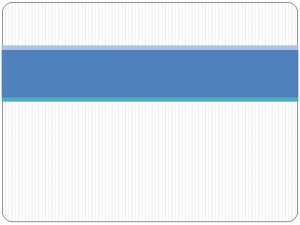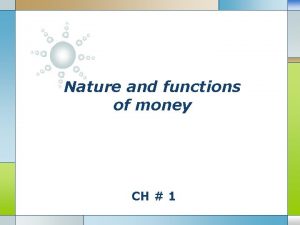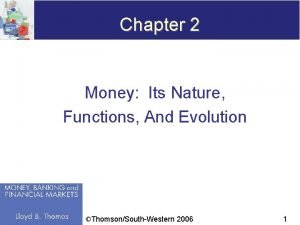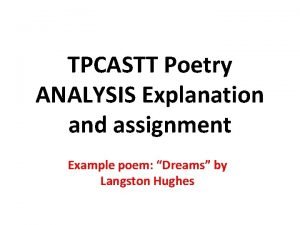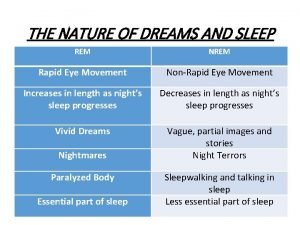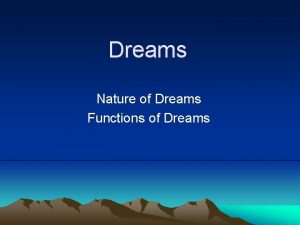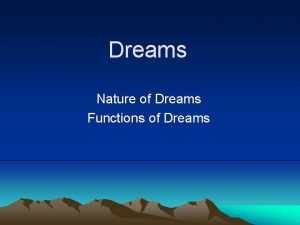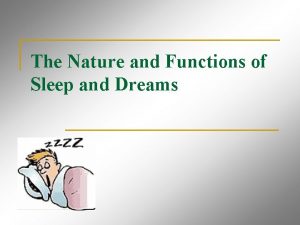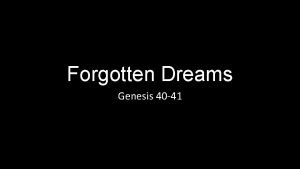Dreams Nature of Dreams Functions of Dreams Nature











- Slides: 11

Dreams Nature of Dreams Functions of Dreams

Nature of Dreams • Most dreams occur during REM sleep but not all! Exam hint: do not discuss REM sleep when asked about dreams!! • Dream content has a deep psychological core. Cartwright 1984 dreams of divorcing couples • Dreams have a noticeable emotional content. Hobson 2000 PET scans show ‘emotional’ sections of brain activated • REM dreams vivid relatively long run through ‘real time’ • NREM mundane short less intense • Dreams full of often bizarre images.

Function of Dreams • Psychological theories assume the meaning of the dream is the function of the dream—Dreams provide a psychological service • Neurobiological theories include Activation-Synthesis Theory and Reverse Learning Theory • Former suggest random electrical activity during REM sleep experienced as a dream • Latter claims brain requires memory consolidation to function effectively and during this process the associated electrical activity produces dreams.

Freud and Dreams • Dreams protect sleeper from irrational urges coming from id. They allow the release of potentially dangerous energy which would otherwise lead to insanity. • Dreams therefore mainly ‘wish fulfullment’ • Dreams nature made up of manifest and latent content. • Dreams ‘royal road’ into the unconscious mind

Cartwright and Problem Solving • Cartwright dreams directly reflect our major emotional concerns • Problem solving takes place during dreaming—deal with preoccupations of waking life. • Dreams provide solutions for work-Kekule and structure of benzene • Dreams provide coping strategies for emotional problems. Mind finds symbols that fit the pressures of the moment.

Commentary Freud • Theory difficult to falsify • Theory based on culturally and historically biased sample of neurotics Viennese woman. • However, PET scans show rational brain switched off during dreaming while forebrain—centre of motivation memory is fully activated—so no ego but id active. • Solms shows dreams activated by forebrain not brain stem. • Condensation supported by computer simulation research. • Are all dreams wish fulfillments—i. e nightmares?

Commentary on Cartwright • Barrett 1993 studied students who were instructed to solve a problem. Over a week a panel of independent judges found 50% dreamt a solution. • Stickgold 2000 found Tetris players dreamt solutions to problems connected to the game. • Cartwright 1984 found couples separating had dreams relating to their waking coping strategies

Hobson and Mc. Carley • Activation-Synthesis. Random internally generated signals from brainstem are ‘synthesized’ by frontal cortex. • Bizarre nature of dreams is the lack of information that brain does its best to interpret and give meaning. • Conclusion personal but meaningless.

Crick and Mitchison • Reverse Learning—we dream to forget. • Parasitic associations are the content of dreams and they are discarded during this process. • Other unwanted memories are also expelled including those that might by pathological—that is obsessional. • Neural networks are kept compact and efficient

Commentary on Neurobiological Theories • Goertzel 1997 estimates 100 billion bits of information taken in by brain during a lifetime but brain has only space for 100 billion bits • Negative correlations between brain sized and REM sleep predicted by theory and found. • Mammals without REM sleep have larger brains. • However, Reverse learning can not explain why dreams are meaningful • Christos 1996 has shown that computer simulations give little support for theory • Capacity of storage for human brain may be underestimated.

• Pet scans give support to Activation-Synthesis—ie. Brain stem active prefrontal cortex not active—frontal lobe active • Explains why dreams are without ‘smell’ as that part of brain inactive. • Animal studies show acetylcholine is the ‘firing’ agent in the brain stem. No acetylcholine no dreams. • However, Solms 2000 found injuries to brain stem REM stopped but dreaming did not.
 Nature and nature's law lay hid in night meaning
Nature and nature's law lay hid in night meaning Determinace lidské psychiky
Determinace lidské psychiky Nature and functions of accountancy for lawyers
Nature and functions of accountancy for lawyers Contingent function of money
Contingent function of money Nature and functions of money
Nature and functions of money Absolute value piecewise function
Absolute value piecewise function How to solve evaluating functions
How to solve evaluating functions Evaluating functions and operations on functions
Evaluating functions and operations on functions Hopes dreams and aspirations
Hopes dreams and aspirations Figurative language in winter dreams
Figurative language in winter dreams Tpcastt analysis example
Tpcastt analysis example What causes night terrors
What causes night terrors


